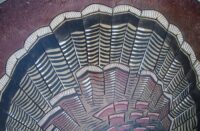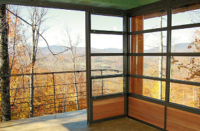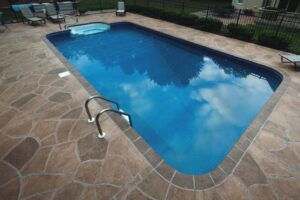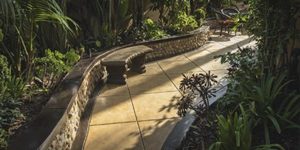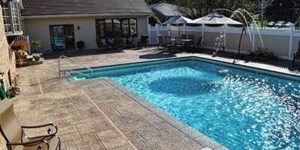Decorative concrete is increasingly gaining popularity as a transformative element that revitalizes commercial outdoor spaces. It serves as a versatile canvas for architects and designers looking to create aesthetically pleasing, durable and cost-effective environments.
The material’s adaptability allows for the creation of unique, customized outdoor spaces that not only enhance visual appeal, but also meet the rigorous demands of commercial properties. From bustling plazas and stylish retail exteriors to attractive driveways and slip-resistant pool decks, decorative concrete offers exceptional design flexibility and performance.
Key Advantages in Commercial Spaces
Some of the biggest benefits of decorative concrete for commercial use are its strength, longevity and aesthetic versatility. When properly installed and maintained, it can withstand heavy use and harsh elements—making it an ideal choice for high-traffic walkways, plazas and pool decks. Decorative concrete offers endless design possibilities—including stamping, staining, polishing and exposed aggregate—that can complement any architectural style or landscaping theme for a unique outdoor space.
Compared to natural stone or brick, decorative concrete can also be more affordable and easier to maintain—offering a high-end look at a fraction of the cost. These sealed surfaces resist stains, moisture and UV damage, requiring only routine cleaning to remain pristine. This low maintenance helps to reduce long-term costs for property owners and managers.
As an eco-friendly material, concrete contributes to sustainable building practices through its longevity and energy efficiency. Locally sourced materials and recycling potential add to these environmental benefits, helping commercial projects achieve sustainability goals. Decorative concrete also enhances safety in areas like pool decks and walkways with slip-resistance textures, such as exposed aggregate.
Yet another key benefit is its ability to add character to any outdoor space by mimicking natural materials like stone, brick or wood, or by creating unique textures and patterns. An example of this is exposed aggregate concrete, such as Increte EZ EXPOSE concrete surface retarder, which can be used to reveal the natural textures and colors of embedded stone.
Popular Commercial Applications
Combining functionality with aesthetic appeal, decorative concrete is an ideal choice for a wide range of residential and commercial applications. This design flexibility allows property owners and managers to transform their outdoor spaces while reaping the advantages of durability and cost-efficiency.
Below are five impactful ways to use decorative concrete in both applications:
1. Patios and Outdoor Living Areas
Decorative concrete is often used to create inviting patios and outdoor living areas for properties such as hotels, restaurants and office complexes. Stamped concrete, for instance, can offer a cost-effective alternative to natural materials in mimicking high-end brick, slate or tile. This technique enables intricate designs that enhance the ambiance and functionality of outdoor spaces. An example is our Increte stamped concrete system.
2. Pool Decks
In areas that surround swimming pools, decorative concrete provides both aesthetic appeal and safety. Textured finishes, such as exposed aggregate, enhance slip resistance and ensure a secure environment for guests. Additionally, the use of cool-touch concrete materials can keep the surface comfortable enough to walk on, even under the hot sun. These features are especially beneficial for commercial properties like resorts and recreational facilities. With the ability to customize colors and patterns, decorative concrete can also complement the overall design theme of the designated pool area—enhancing the visual experience for guests.
3. Walkways and Driveways
Decorative concrete can greatly enhance curb appeal by transforming functional walkways and driveways into attractive features that unify a property’s landscaping and architecture. Stained concrete, for example, can offer a more organic, variegated look that enhances the natural beauty of concrete while providing exceptional durability and low maintenance. In addition, stamped concrete can replicate the appearance of more expensive materials such as stone or brick, which adds an upscale touch without the hefty price tag.
4. Garden Features
From retaining walls to decorative planters, concrete offers a versatile medium for creating custom garden features that blend seamlessly with natural surroundings. These elements can be designed to complement the landscaping while providing functional benefits such as soil retention and plant support. Polished concrete, for example, can be used for sleek, modern planters and garden sculptures that add a touch of elegance to outdoor spaces. The durability of concrete ensures these features can withstand the elements over time.
5. Public Spaces and Commercial Projects
Parks, plazas and commercial developments benefit from the durability and design flexibility of decorative concrete. Because they allow existing concrete surfaces to be rejuvenated with new textures, colors and patterns, overlay systems such as our LEVEL TOP PC-AGG polishable concrete overlay are ideal for renovating worn-out or outdated concrete without the need for complete replacement. This technique can be used to create unique, inviting public spaces that withstand heavy foot traffic and environmental exposure.
Achieving the Desired Look with Decorative Concrete
Employing the appropriate concrete mix, sealant and installation techniques are all crucial first steps to prevent cracking and ensure longevity with decorative concrete—especially in regions that are exposed to extreme temperatures and freeze-thaw cycles. The choice of materials and installation methods directly impacts the durability and performance of the concrete. Professional installation ensures that the concrete is properly mixed, poured and finished to achieve the desired look and performance.
Understanding the expected lifespan and performance characteristics of decorative concrete can also help property owners and managers make more informed decisions about their outdoor investments. Knowledge of the material’s behavior under various conditions can guide their choices in design and maintenance. While decorative concrete is low maintenance in nature, periodic resealing may be necessary to preserve its appearance and protective qualities—particularly in high-traffic areas. Regular inspections and maintenance can help to extend the lifespan of decorative concrete surfaces, preventing minor issues from becoming major problems over the life of the concrete.
Finally, it’s important to integrate decorative concrete into a cohesive design that complements existing landscaping, architecture and other outdoor features. This requires careful planning and consideration for elements like color, texture and scale to ensure a harmonious results. Collaboration with the concrete manufacturer, landscape architects and designers can help to provide valuable insights into the selection of decorative concrete finishes and patterns that best suit the project’s goals. For example, our Increte Color-Crete integral color system and Increte Stone-Crete architectural formliner system are ideal for customizing the look of outdoor spaces. Thoughtful integration enhances the overall aesthetic and functional appeal of the space, creating a seamless transition between different elements and maximizing the impact of the decorative concrete.
Decorative concrete represents a fusion of artistry and functionality, offering limitless possibilities for enhancing outdoor spaces. Whether used for designing patios, driveways or garden features, its versatility and aesthetic appeal make it a preferred choice in both residential and commercial construction. By taking all of these factors into consideration, these properties can achieve a stunning, durable and cohesive outdoor space that not only meets but exceeds expectations.
